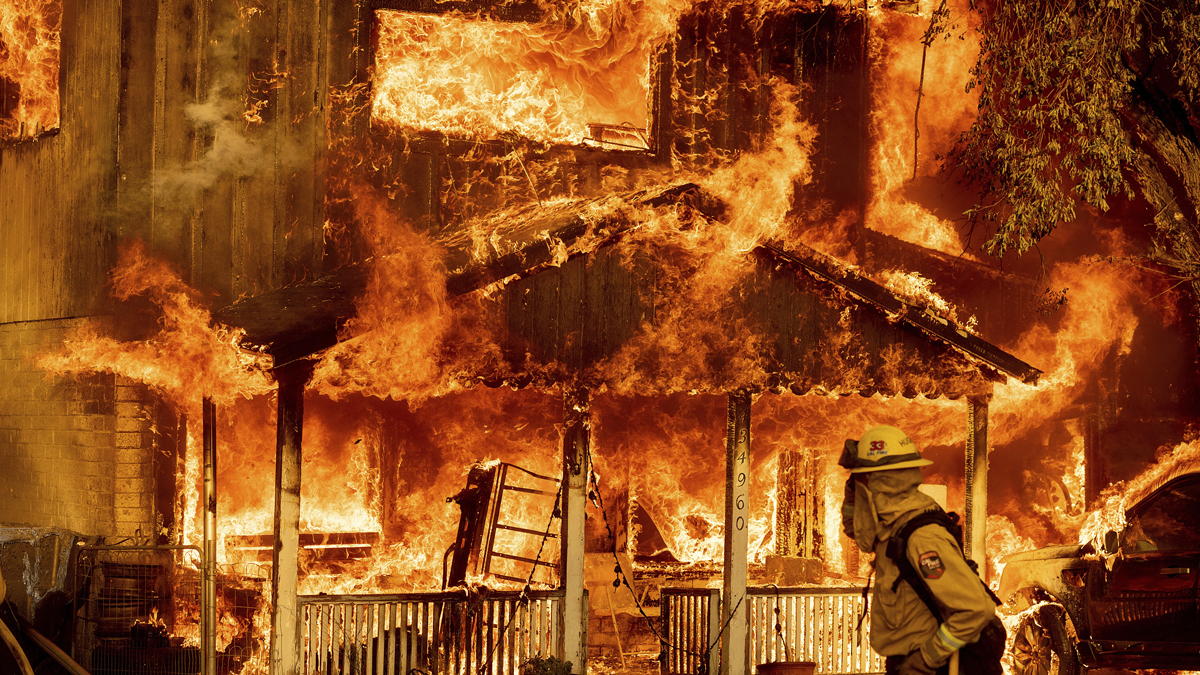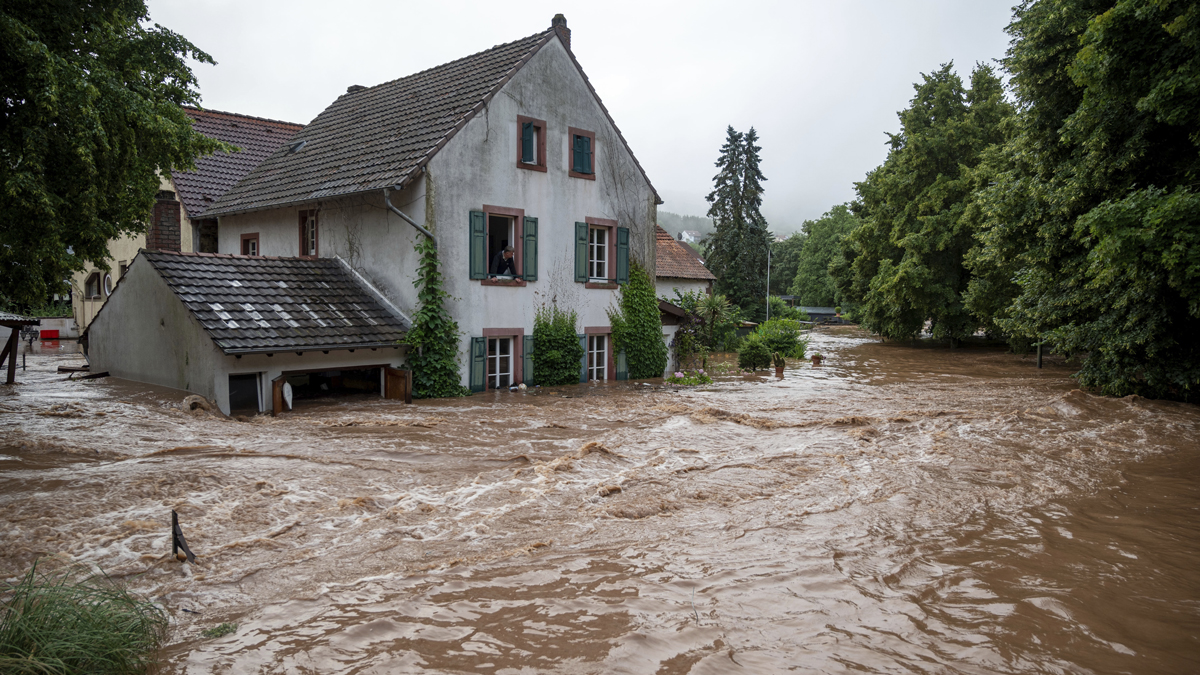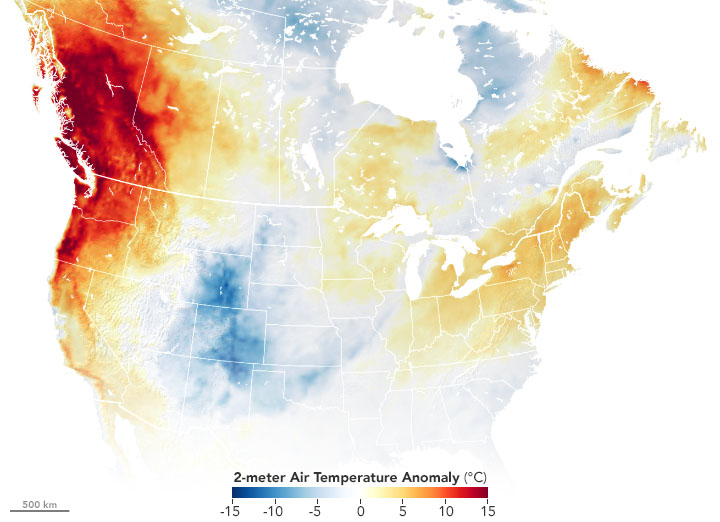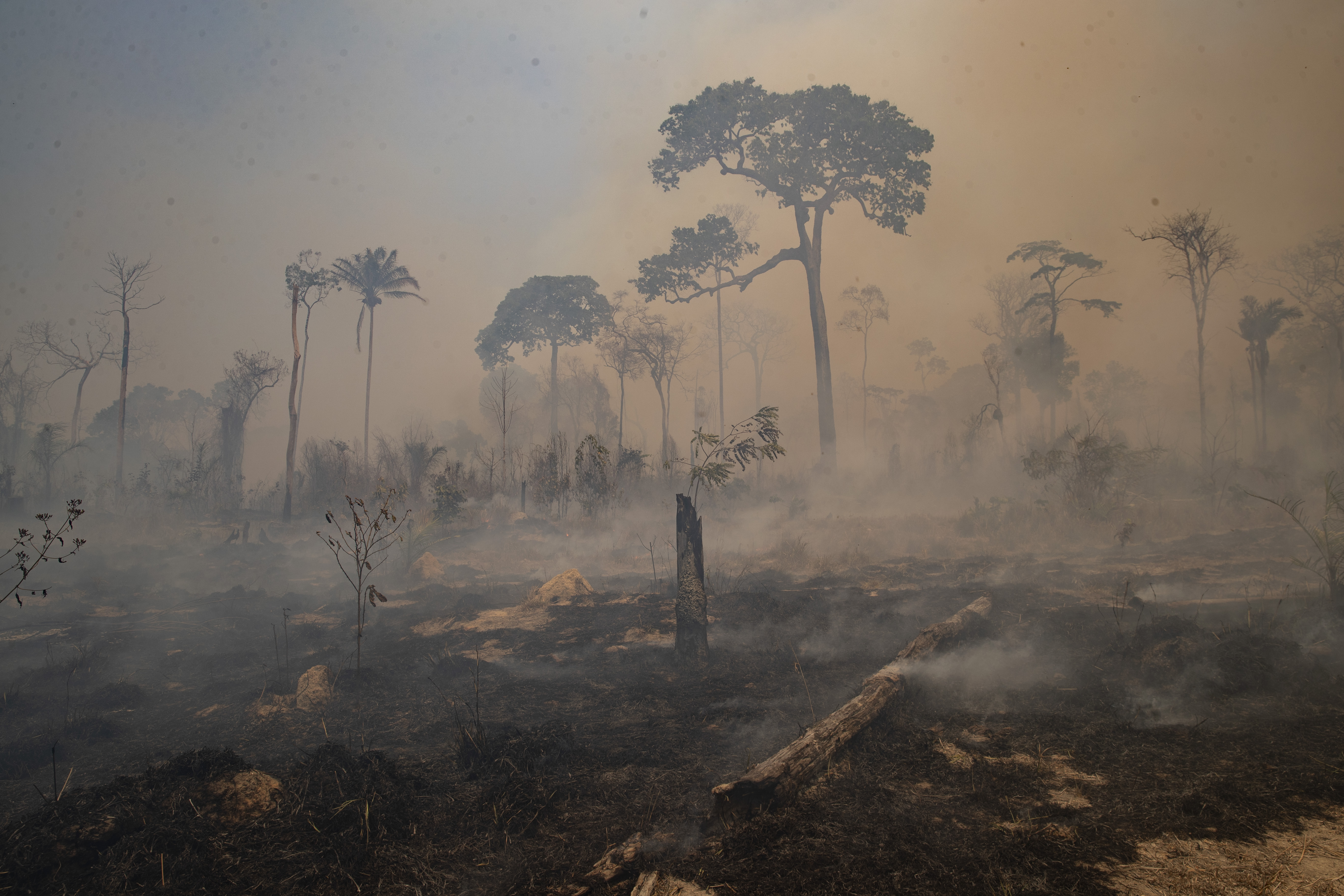Signs of Accelerating Climate Crisis: Record Floods... Raging Fires and Heat Waves... Amazon Carbon Emissions
| revcom.us

Dozens of fires this year in Western states point to possibly another devastating wildfire season, following last year's fires, unprecedented in size and ferocity. Here, Beckwourth Complex Fire tears through Doyle, California, July 10. Photo: AP
Just in the past couple of weeks, there have been a number of major developments around the world, pointing to how the climate crisis is intensifying and accelerating.
Devastating Floods Hit Europe
On Wednesday, July 14, a slow-moving storm dumped as much as two months’ worth of rain in a single day on parts of western Europe, especially Germany. The massive rainfall caused rivers to overflow and flooded huge areas, devastating many communities as houses were reduced to rubble and roads and bridges destroyed. Some areas were completely cut off by the flash floods. The deadly flooding also hit Belgium, Luxembourg, and the Netherlands.1 As of Sunday, at least 180 people have reportedly lost their lives because of the floods, and many are still missing.2

A slow-moving storm dumped as much as two-months’ worth of rain in a single day on parts of western Europe. This kind of “extreme weather event” is becoming increasingly common because of global climate change. Here, Erdorf, Germany, July 15. Photo: AP
One resident in the city of Hagen in the North Rhine-Westphalia region of Germany said, “It was just this situation where the street was completely [turned] into a river, basically like a wild river.” A government official said, “The situation is enormously difficult and enormously dangerous,” and that rescuers had carried out 30,000 missions, including from hospitals and nursing care homes.3
This kind of “extreme weather event” is becoming increasingly common because of global climate change. A New York Times piece on the link between these European floods and climate change4 noted, “Already studies have shown an increase in extreme downpours as the world warms, and the Intergovernmental Panel on Climate Change, the United Nations-backed group that reports on the science and impacts of global warming, has said that the frequency of these events will increase as temperatures continue to rise.”
Because of the warming of Earth’s atmosphere due to greenhouse gases produced by the burning of fossil fuels, the air holds more moisture, which in turn makes it more likely that specific storms will produce heavier rainfalls. Hayley Fowler, a climate scientist at Newcastle University in England, said, “These kind of storm events will increase in intensity.” (At the same time, the effects of climate change are also leading to other types of extreme weather events in other parts of the world, such as longer droughts, stronger hurricanes, faster melting of glaciers, etc.)
Deadly Heat Waves and Burning Forests in the U.S. West
The weekend of July 17 brought the fourth major heat wave to hit the western U.S. already this year. A record-breaking high of 107 degrees is forecast for Bozeman, Montana, on Monday, and places like Boise, Idaho, and Salt Lake City, Utah, are expected to see triple-digit temperatures. The previous weekend, California’s Death Valley recorded a 130-degree high, matching the temperature reached last year that “may be the highest reliably recorded temperature on earth.”5
In late June and early July, a series of deadly heat waves had hit the Pacific Northwest, with Portland, Oregon, reaching 116 degrees and shattering records for the city. Hundreds of deaths in Oregon, Washington, and British Columbia, Canada, were linked to the extreme heat. A public health official in Multnomah County, Oregon, where dozens of people ranging in age from 44 to 97 died from heat-related causes, said, “This was a true health crisis that has underscored how deadly an extreme heat wave can be, especially to otherwise vulnerable people. I know many county residents were looking out for each other and am deeply saddened by this initial death toll. As our summers continue to get warmer, I suspect we will face this kind of event again.”6

Red areas are where air temperatures in 2021 climbed more than 27°F (15°C) higher than the 2014-2020 average for the same day. Credit: NASA
Along with the latest heat wave in the West, a fast-moving wildfire in Oregon—known as the Bootleg fire—has already burned more than 200,000 acres as of July 17 and is less than 10 percent contained.7 An Oregon forestry official said, “This fire is going to continue to grow; the extremely dry vegetation and weather are not in our favor.” This is the largest of nine currently active fires in Oregon—and dozens of other fires have been raging in other western states, including California, Idaho, Montana, and Arizona. These fires point to the possibility of another devastating wildfire season in the western U.S.—following the widespread fires last year in 12 western states that were unprecedented in size and ferocity.8
As with the floods in Europe, the heat waves and wildfires in the U.S. West are linked to climate change. The New York Times noted, “The record-high temperatures that assaulted the Pacific Northwest in late June and early July ... would have been all but impossible without climate change, according to a team of researchers who studied the deadly heat wave. Heat, drought and fire are connected, and because human-caused emissions of heat-trapping gases have raised baseline temperatures nearly two degrees Fahrenheit on average since 1900, heat waves, including those in the West, are becoming hotter and more frequent.”9
Rising Carbon Emissions from the Amazon Rainforest
The Amazon rainforest is often called the “lungs of the planet” because it puts so much oxygen into the atmosphere. It has also been known as a major “carbon sink,” because it absorbs about five percent of the carbon dioxide that is emitted annually from the burning of fossil fuels. Carbon dioxide is one of the main greenhouse gases behind global warming and the climate crisis.
According to a research report published July 14 in the journal Nature, “This carbon sink seems to be in decline, however, as a result of factors such as deforestation and climate change... Over the past 40 years, eastern Amazonia has been subjected to more deforestation, warming and moisture stress than the western part, especially during the dry season.”10
The researchers, led by Brazil’s National Institute for Space Research, made nearly 600 flights over four areas in the Amazon rainforest, collecting data. They found that these sites emit 410 metric tons of carbon dioxide per year, mainly from large fires mostly set by people. This is partially offset by these areas absorbing about 120 metric tons of carbon annually—but that means about 290 metric tons in net carbon emissions. These areas of the Amazon are no longer acting as a “carbon sink” but, instead, actually are contributing significant amounts of greenhouse gases into the Earth’s atmosphere.11

The Amazon rainforest'—the lungs of the planet—is less able to absorb carbon emissions in the last 40 years due to deforestation and climate change. Here, fire consumes recently deforested land in Brazil, August 2020. Photo: AP
John Miller, one of the study’s lead authors, told CBS News, “It’s a really big warning that we’re seeing happening over a really pretty significant area. And if we don’t take steps now ... things are going to get worse. We’re going to be in more trouble.”12
***
These are just some of the recent manifestations of accelerating climate change that is already having huge—and often deadly—effects across the world. The climate crisis is a crisis of unprecedented and existential dimensions—threatening the ecosystems of the planet and life itself. To get into what underlies this crisis, and what must be done—go to the revcom.us climate change resource page: Capitalism-Imperialism Is Destroying the Planet... Only Revolution Gives Humanity a Real Chance to Save It.
1. Desperate search for survivors as western Europe reels from a ‘catastrophe of historic proportion’, CNN, July 17, 2021 [back]
2. Germany comes to grips with massive flood damage as some regions brace for more rains, Washington Post, July 18, 2021 [back]
3. More than 100 dead, as many as 1,500 missing after floods hit Europe, NBC News, July 15, 2021 [back]
4. ‘It Is All Connected’: Extreme Weather in the Age of Climate Change, New York Times, July 16, 2021 [back]
5. Heat Wave Updates: Triple-Digit Heat to Afflict Northern Rockies, New York Times, July 17, 2021 [back]
6. News Release: Multnomah County Medical Examiner finds 45 deaths related to historic heat wave, Multnomah County, June 30, 2021 [back]
7. The Bootleg fire in Oregon is among more than 60 wildfires in the U.S., New York Times, July 17, 2021 [back]
8. West Coast Forest Fires: Escalating Infernos Fueled by Climate Change, revcom.us, September 14, 2020 [back]
9. Climate change is playing a role in the West’s heat, drought and fires, New York Times, July 12, 2021 [back]
10. From abstract to Amazonia as a carbon source linked to deforestation and climate change, Nature, July 14, 2021 [back]
11. Amazon rainforest is emitting more carbon dioxide than it absorbs in some areas, study says, CNN, July 15, 2021 [back]
12. Part of the Amazon is emitting more carbon dioxide than it absorbs — and it’s a “really big warning” for the planet, CBS News, July 14, 2021 [back]
NEW YEAR’S STATEMENT BY BOB AVAKIAN
A New Year,
The Urgent Need For A Radically New World—
For The Emancipation Of All Humanity
Get a free email subscription to revcom.us:


